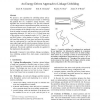Free Online Productivity Tools
i2Speak
i2Symbol
i2OCR
iTex2Img
iWeb2Print
iWeb2Shot
i2Type
iPdf2Split
iPdf2Merge
i2Bopomofo
i2Arabic
i2Style
i2Image
i2PDF
iLatex2Rtf
Sci2ools
COMPGEOM
2004
ACM
2004
ACM
An energy-driven approach to linkage unfolding
We present a new algorithm for unfolding planar polygonal linkages without self-intersection based on following the gradient flow of a “repulsive” energy function. This algorithm has several advantages over previous methods. (1) The output motion is represented explicitly and exactly as a piecewise-linear curve in angle space. As a consequence, an exact snapshot of the linkage at any time can be extracted from the output in strongly polynomial time (on a real RAM supporting arithmetic, sin, and arcsin). (2) Each linear step of the motion can be computed exactly in O(n2 ) time on a real RAM where n is the number of vertices. (3) We explicitly bound the number of linear steps (and hence the running time) as a polynomial in n and the ratio between the maximum edge length and the initial minimum distance between a vertex and an edge. (4) Our method is practical and easy to implement. We provide a publicly accessible Java applet [1] that implements the algorithm.
| Added | 30 Jun 2010 |
| Updated | 30 Jun 2010 |
| Type | Conference |
| Year | 2004 |
| Where | COMPGEOM |
| Authors | Jason H. Cantarella, Erik D. Demaine, Hayley N. Iben, James F. O'Brien |
Comments (0)

